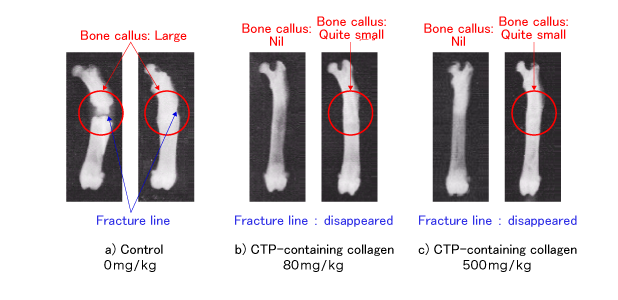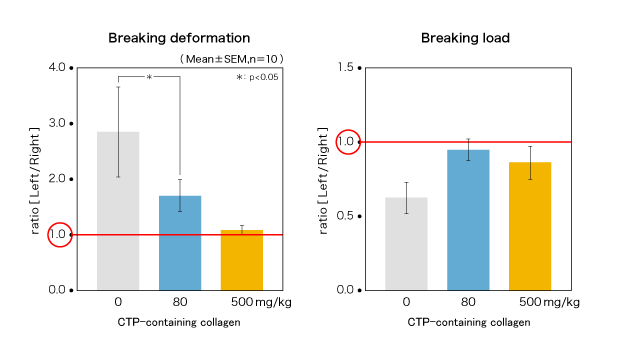
Promotion of healing of bone fracture (in vivo)
Collagen is a fundamental component for bone to keep its flexibility and strength, because it accounts for 90% of organic components of the bone and plays an important role in fixing hydroxyapatites (a compound of calcium and phosphoric acid) to the bone. As we face an aging society, the problems of bone aging/disease have grown more serious often causing elderly people to be bedridden due to causes like bone fracture, osteoporosis, and so on. In this situation, the necessity of foods and medicines which are effective for preventing/healing these symptoms has increased. Thus, we studied the effect of oral ingestion of CTP-containing collagen on the healing process of fractured bones.
Test for promotion of healing of bone fracture
1) Methods
Male SD rats at 7 weeks age fractured intentionally on the left femurs were prepared as a bone fracture model, randomly divided into 3 groups, and administrated CTP-containing collagen orally at a dosage of 0, 80, and 500 mg/kg per day for 12 weeks. The day after that period, the pairs of right and left femur of each model were removed and healing level of the bone fracture was evaluated by X-ray photography, and the bone strength measured (three-point bending test). From the bone strength measurement results, when the ratio (left/right) of measured value between a non-fractured right femur and a fractured left femur was closer to 1.0, we concluded that the fractured left femur had recovered to a normal level.
2) Results

The soft-X-ray photographs of fractured left femurs of the rats are shown in Figure 1. The photo of the "control (0 mg/kg)" group showed a comparatively large bone callus and a distinct fracture line. That is, the fracture was in the early process of healing. In contrast, the "CTP-containing collagen" (administration) groups showed advanced calcification or elimination of bone calluses, increase of continuity of the cortical bones, and disappearance of the fracture lines. That is, these were in an accelerated level of fracture healing.
The results of the bone strength measurement is shown in Figure 2. In the "control" group, the value of breaking deformation, which indicated distortion and bending levels when the fracture was caused, was large and it meant that connection and calcification at the bone fracture locations were not sufficient. However, in the "CTP-containing collagen" group, the value became closer to the normal ratio (=1.0) dose-dependently. In addition, the value of the breaking load in the "CTP-containing collagen" group also became closer to the normal ratio, and we observed that the fractured left femur regained its strength to almost the same level as that of the non-fractured right femur.
Figure 1: Soft-X-ray photographs (typical example)

Figure 2: Result of the bone strength measurement

3) Discussion

As a result of above studies using bone fracture model rats, we confirmed the effect on promotion of healing of bone fracture by oral ingestion of CTP-containing collagen. Thus,we can expect that CTP-containing collagen will greatly contribute to prevent/ heal serious problems such as bone fracture and osteoporosis caused by bone aging in an aging society.



